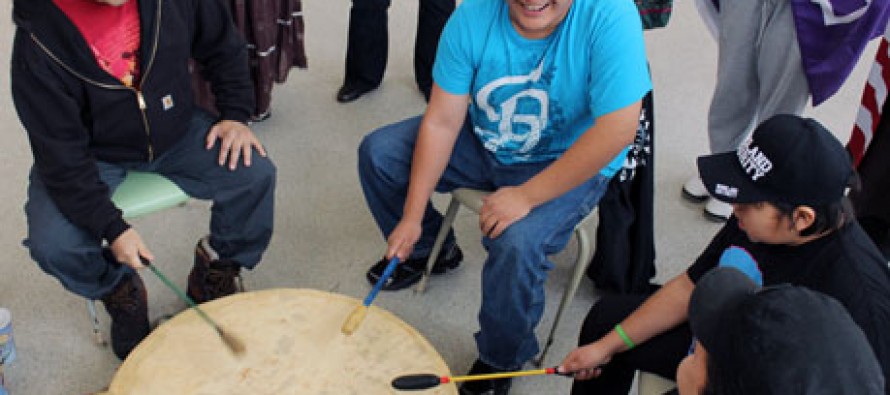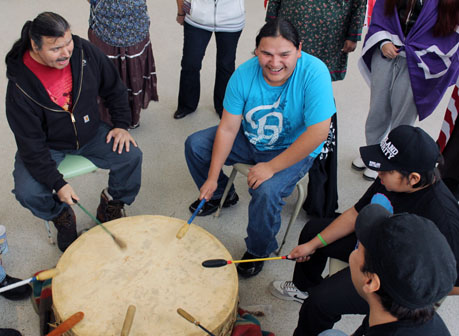Idle No More to the beat of the drum


Francis Sarazin, left, and Garret Deperry lead a drum circle at the Idle No More rally held at the University of Windsor’s CAW Student Centre Jan. 11. The sound of Indigenous drumming can be heard at such events from coast to coast. (Y. MURAD ERZINCLIOGLU/ The Converged Citizen)
By: Murad Erzinclioglu
Boom. Boom. Boom. The sound of native drums is echoing in communities from coast to coast.
The sound of the First Nations drumming has become synonymous with the Idle No More movement. According to the movement’s website, “Idle No More urges the government of Canada to repeal all legislation which violates Treaties, Indigenous sovereignty and subsequently environmental protections of land and water.” Bill C-45, an omnibus bill that affects the Indian Act, the Navigation Protection Act and the Environmental Assessment Act, is a notable concern to the movement.
Demonstrations and rallies have been going on for weeks throughout the country, some of which have taken place in Windsor. Almost all Idle No More events begin and end with traditional First Nation drum circles and the recent rallies at the University of Windsor and Ambassador Bridge were no exception.
The drums are individually hand crafted and unique unto themselves. The drum-maker uses a wooden frame, bent, carved or pieced together and covered on one or both sides. Native people have used deer, moose, caribou, elk, cow and even fish skins to make drum heads. The choice of hide depends on either what is available or what a specific tradition might prescribe.
Garret Deperry, 30, is studying to become a child and youth worker. He is a part of the Woodland Ojibway nation and led the drum circle at the Idle No More rally that took place at the University of Windsor Jan. 11.
“The drum is used as the heartbeat of our nation, that’s what it was given to us for. It’s a way for us to join together, express ourselves, the drum plays a major role in that … I think its plays a very big role for us because it gathers us, it brings us together,” Deperry said.
Retired teacher and artist Phylmarie Fess of the Ojibway nation is also attended the rally on Jan. 11. She says the music doesn’t only act as a tool to draw a crowd together but a way to honour the environment.
“One of our wonderful traditions is called an honour song. It is always so heartfelt it just reverberates (with us). When we hear the drum, this is a sacred drum, it resonates with the heartbeat of mother earth. This is why, when we hear it, we come because it resonates right through us. It’s like being called,” said Fess.
With the Idle No More movement going into its eighth week and House of Commons reopening Jan. 28, it’s not likely that the beating of the drums will stop anytime soon.
For more information about the Idle No More movement go to www.idlenomore.ca.


